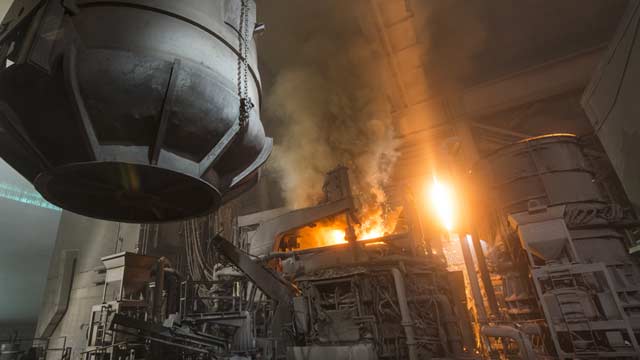
There’s no getting around the fact that a changing climate affects us all and therefore requires a global response. Steel Dynamics, Inc. (SDI) and New Millennium Building Systems recognize our role to play, and we’re proud of our efforts to reduce our impact on the environment and the climate using sustainable practices. We also recognize there’s more work to do.
Steel is 100 percent recyclable and is the most recycled material in the world. That allows Steel Dynamics to utilize a looped manufacturing life cycle to mitigate its environmental impact.
It works this way: A metals recycling platform collects and processes industrial scrap from manufacturers and obsolete scrap from end-of-life items such as automobiles, appliances and machinery. This processed scrap is then sold to end users, including SDI electric arc furnace (EAF) steel mills, which use recycled ferrous scrap as their primary raw material input to produce new steel. In turn, this steel is sold internally to steel manufacturing operations such as New Millennium and to external steel customers.
Our process allowed us to reintroduce over 33 million tons of recycled ferrous scrap materials and 3.3 billion pounds of nonferrous scrap materials into the manufacturing life cycle from 2017 through 2019.
“We are driven to use our resources wisely and to develop innovative solutions to help in this conservation process,” Steel Dynamics, Inc. CEO Mark Millett says in the 2019 Sustainability Report.
Making the most of resources and limiting waste is important on two levels, says Justin Hoover, environmental manager at New Millennium.
“By everybody doing their part in minimizing waste, not only do we impact the environment in a positive way, but we also can reduce our cost,” he says.
Steel Dynamics is one of a small number of steel producers that exclusively uses EAF steelmaking technology, which requires far fewer natural resources and significantly less energy than traditional blast furnace technology. That means fewer emissions and a lower impact on the environment. New Millennium products are primarily made of steel from domestic EAF mills, including those of SDI.
Ferrous scrap metal is the primary ingredient for EAF mills, which is why the steel industry is a consistent leader in recycling and sustainability. Much of this scrap coms from SDI metals recycling operations. This benefits our steel mills with lower working capital, lower cost and higher-quality recycled raw materials.
In 2019, 84 percent of the material used in SDI furnaces to produce steel at six EAF steel mills was recycled ferrous scrap and internally generated iron substitutes. In traditional blast furnace steelmaking, on the other hand, recycled ferrous scraps makes up only 25 percent to 35 percent of material used.
Some other benefits realized in 2019 using EAF steelmaking technology:
EAF operations, on a per metric ton basis, required only 25 percent of the energy intensity of average steel operations worldwide, when compared to the World Steel Association.
We generated only 12 percent of the greenhouse gases, on a per metric ton basis, of average U.S. blast furnace steelmaking operations.
Our EAF operations recycled and reused 100 percent of water withdrawn. Further, the average gallon of water was recycled and reused multiple times before it was lost either to evaporation or discharge.

SDI Mill Columbia City, Indiana

EAF Furnace
It’s not in our nature to just be satisfied with established sustainable practices and standards. That’s why SDI and New Millennium are continually using innovative thinking and actions to further our sustainable practices.
Using a unique process, newly created Iron Dynamics Inc. produces liquid pig iron from steel waste streams and other secondary materials. We use this liquid pig iron as a raw material substitute for merchant pig iron and prime scrap. Because liquid pig iron is delivered in a molten state, it introduces productivity gains and cost savings at the steel mill, including a reduction in energy requirements and electrode consumption. This leads to lower emissions. Between 2017 and 2019, IDI converted more than 1.2 million tons of mill scale and other related material from steel companies throughout the U.S. and Canada into liquid pig iron.
As part of our resource recovery work, IDI began collecting the dust produced during the steelmaking process and reusing it. More than 20,000 tons of EAF dust were collected in 2019 and used in other manufacturing processes.
More than 50 percent of the EAF dust generated at the Butler Flat Roll Division is now being processed by IDI with plans to recycle 100 percent in the near future. This unique technology provides an economic benefit through the sale of the crude zinc oxide, the reuse of the iron units, and the reduction of third-party processing or landfill costs.
Not content to be the largest nonferrous metals recycler in the U.S., our company has invested $40 million over the years to increase recovery of nonferrous and other materials from our automotive shredding operations. This has resulted in more than 200 million pounds of additional reusable materials each year.
New Millennium plants in North America primarily use steel from domestic EAF mills, which rely heavily on scrap steel. In its LEED Letter, New Millennium reports the average percent of recycled content used at each facility in finished steel joists and deck. LEED recycled content ranges from 40 percent to 85 percent across our seven North American facilities.
For current data on the recycled content of New Millennium products, see our LEED Letter.

Keep workers safe and protect owner budgets with a properly specified fall arrest anchorage system. Too often, this isn’t done safely or correctly. Here are two recommended solutions.

Weather, congested locations, potentially dangerous building environments or historic structures can impede construction progress. The right building system and supplier can help move your project forward.
Building a better steel experience